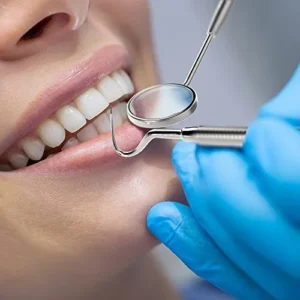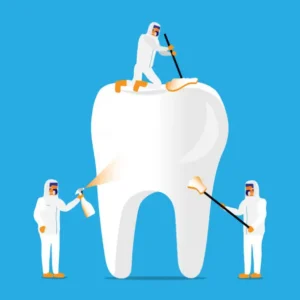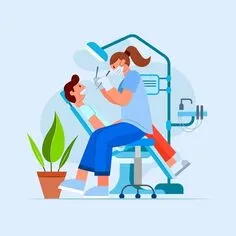What Is the Difference Between Dental Cleaning and Dental Polishing?
Maintaining good oral hygiene is crucial for overall health, and dental professionals play a significant role in ensuring our teeth stay healthy. Two common procedures dentists and hygienists perform are dental cleaning and polishing. While these terms are often used interchangeably, they serve distinct purposes and have different benefits. In this blog, we will delve into the differences between dental cleaning and dental polishing, explore their benefits, and understand why both are essential for optimal oral health.

What is Dental Cleaning?
Dental cleaning, also known as prophylaxis, is a preventive procedure performed by a dental hygienist or dentist. It involves the thorough removal of plaque, tartar (calculus), and stains from the teeth and gums. Dental cleaning typically includes the following steps:

- Examination:Before starting the cleaning process, the dental professional examines your mouth. They check for signs of oral health issues such as cavities, gum disease, or other abnormalities.
- Scaling: This step involves the use of specialized tools, such as ultrasonic scalers and hand instruments. These tools remove plaque and tartar buildup from the surfaces of the teeth, including areas below the gum line.
- Root Planing: In cases of advanced gum disease, root planing may be performed. This involves cleaning the roots of the teeth to remove bacteria and smooth rough spots that can harbor harmful microbes.
- Flossing and Rinsing: After scaling and root planing, the hygienist will floss between your teeth to remove any remaining debris and rinse your mouth to wash away loosened particles.
Benefits of Dental Cleaning
Regular dental cleanings offer numerous benefits, including:
- Prevention of Gum Disease: By removing plaque and tartar, dental cleanings help prevent gum disease (gingivitis and periodontitis), which can lead to tooth loss if left untreated.
- Cavity Prevention: Plaque contains bacteria that produce acids, which can erode tooth enamel and lead to cavities. Regular cleanings reduce the risk of cavities by keeping plaque under control.
- Fresher Breath: Plaque and tartar buildup can cause bad breath. Dental cleanings help eliminate odor-causing bacteria, resulting in fresher breath.
- Early Detection of Oral Health Issues: During the examination, dental professionals can identify early signs of problems such as cavities, oral cancer, and other conditions, allowing for prompt treatment.
- Aesthetic Improvement: Clean teeth look healthier and brighter, contributing to a more attractive smile.
The Risks of Not Getting Your Teeth Cleaned on a Regular Basis
Neglecting regular dental cleanings can have several negative consequences, including:
- Gum Disease: Without regular cleanings, plaque and tartar buildup can lead to gum inflammation (gingivitis) and eventually progress to more severe gum disease (periodontitis), which can result in tooth loss.
- Tooth Decay: Plaque buildup increases the risk of cavities and tooth decay, which can lead to pain, infection, and the need for extensive dental treatments such as fillings, root canals, or extractions.
- Bad Breath: Poor oral hygiene and the accumulation of plaque and tartar can cause persistent bad breath (halitosis).
- Stains and Discoloration: Regular cleanings help remove surface stains caused by food, beverages, and tobacco, keeping your teeth looking whiter and brighter.
- Systemic Health Issues: Poor oral health has been linked to various systemic health problems, including heart disease, diabetes, and respiratory infections. Regular dental cleanings help reduce the risk of these conditions.
What is Dental Polishing?
Dental polishing is a procedure performed after dental cleaning to smooth and shine the surfaces of the teeth. It involves the use of a polishing tool and a special paste that contains mild abrasives. The polishing process typically includes the following steps:

- Polishing Paste Application: The dental hygienist applies a polishing paste, which may contain fluoride or other agents, to the teeth.
- Polishing: Using a rubber cup or brush attached to a hand piece, the hygienist polishes the teeth, focusing on the front, back, and chewing surfaces. The mild abrasives in the paste help remove surface stains and smooth the tooth surfaces.
Benefits of Dental Polishing
Dental polishing offers several benefits, including:
- Smoother Teeth: Polishing smooths the surfaces of the teeth, making it harder for plaque and bacteria to stick, which helps maintain oral hygiene.
- Brighter Smile: The polishing process removes surface stains, resulting in a brighter and more radiant smile.
- Enhanced Comfort: Smooth tooth surfaces are less likely to cause irritation to the gums and cheeks.
- Improved Oral Health: By reducing plaque retention, polishing can contribute to better overall oral health and decrease the risk of cavities and gum disease.
Dental Polishing vs Dental Cleaning
While both dental cleaning and dental polishing are important for maintaining oral health, they serve different purposes:
- Purpose: Dental cleaning focuses on removing plaque, tartar, and stains to prevent oral health issues, while dental polishing aims to smooth and shine the teeth after cleaning.
- Procedure: Dental cleaning involves scaling and, if necessary, root planing, followed by flossing and rinsing. Dental polishing involves applying a polishing paste and using a rubber cup or brush to smooth the tooth surfaces.
- Benefits: Dental cleaning helps prevent gum disease, cavities, bad breath, and other oral health issues. Dental polishing enhances the appearance of the teeth, makes them smoother, and reduces plaque retention.
- Frequency: Dental cleanings are typically recommended every six months, although the frequency may vary based on individual oral health needs. Dental polishing is usually performed as part of the cleaning process.
Conclusion
In summary, dental cleaning and dental polishing are two essential components of professional dental care. Dental cleaning focuses on removing plaque, tartar, and stains to prevent oral health issues. Dental polishing smooths and shines the teeth, enhancing their appearance and reducing plaque retention. Regular dental visits for both cleaning and polishing are crucial for maintaining optimal oral health, preventing gum disease and cavities, and ensuring a bright and beautiful smile. By understanding the differences between these procedures and their respective benefits, you can take proactive steps to maintain your oral health and overall well-being.
Leave a reply

Most Commented